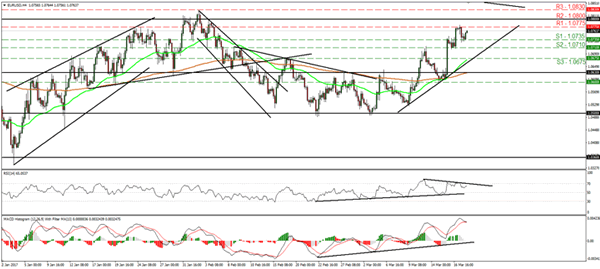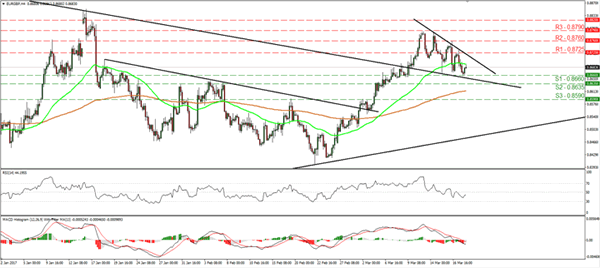The common currency gave back some of its recent gains on Friday, following the release of a poll on the French presidential election. The poll showed that although the far-right Eurosceptic candidate Marine Le Pen is still expected to lose the 2nd voting round, she has recovered some ground on her main rival, Emmanuel Macron. EUR/USD slid after it hit resistance near the 1.0775 (R1) level, but the slide was stopped near 1.0735 (S1). However, the pair recovered all of its aforementioned losses during the Asian morning Monday, perhaps due to a poll released on Sunday showing that Macron would lead the first round, and also beat Le Pen in the second round by a larger margin than previous polls showed. At the time of writing, the rate looks to be headed for another test near the 1.0775 (R1) resistance, where a clear break is possible to aim for a test near the very important territory of 1.0800 (R2).
We think that the common currency is likely to become increasingly more responsive to fresh polls heading into the ballots, considering that polls released a few weeks ahead of the elections may bear more importance in the eyes of investors. What’s more, today the first French presidential debate between the 5 most popular candidates is set to take place. Depending on who the market sees as the winner of the debate, there could be an impact on the common currency. A strong showing by Le Pen could add momentum to her campaign and considering her anti-European views, it may prove a cause for euro weakness. Given that EUR/USD is trading close to the key resistance of 1.0800 (R2), this could encourage the bears to take advantage of that zone and initiate new short positions. On the other hand, if Macron is seen as emerging victorious, market participants could price out some probability of European disintegration. This is likely to fuel further the latest recovery in EUR/USD and it could even prove the catalyst for a clear break above the 1.0800 (R2) zone. Zooming out to the daily chart, we see that the 1.0800 (R2) critical resistance is also the neckline of a possible inverted head and shoulders formation. As such, a clear close above 1.0800 (R2) and the downtrend line taken from the peak of the 3rd of May 2016 could signal the completion of the pattern, and in combination with a potential defeat of Le Pen in the second round, it could lead to a medium-term trend reversal.
EUR/GBP got hit by Friday’s poll as well and slid from 0.8725 (R1) to hit support at 0.8660 (S1), near the downside resistance line drawn from the peak of the 11th of October. The fact that the rate is still trading above that line leaves the door open for the bulls to enter the market and push the pair higher. Nevertheless, we would like to see a decisive break above the upper bound of the falling wedge that has been in place since the 10th of March before we get confident on such a rebound. The trigger for such a break could be a poor showing by Le Pen in today’s debate.
G20 drop commitment to resist protectionism
Over the weekend, the financial leaders of the G20 nations did not reiterate a long-standing pledge to resist protectionism in their statement, amid opposition from the US. Even though there was no major FX market impact, this highlights the risk that the Trump administration could pursue a more protectionist approach on trade policy, in line with what the US President vowed on the campaign trail. In our view, this increased risk of global protectionism could have an impact on the rhetoric of the RBNZ and the RBA, considering that both of those economies are heavily export-oriented. In particular, at the latest RBNZ meeting Governor Wheeler indicated that one of the biggest risks he sees is US President Trump’s potential protectionist trade policies. As such, we believe that this could fuel an even more cautious stance from the Bank when it meets on Wednesday (see below).
Today’s highlights: The European day is particularly light, with no major events or indicators due to be released.
Besides the French presidential candidates, we have two more speakers on today’s agenda: BoE Chief Economist Andy Haldane and Chicago Fed President Charles Evans.
As for the rest of the week, on Tuesday, the UK will release its CPI data for February. The forecast is for both the headline and the core rates to have risen, which could heighten market expectations with regards to a potential reduction in BoE stimulus.
On Wednesday, late during the day, the RBNZ rate decision will be in the spotlight. Expectations are for no change in policy. At its latest gathering, the Bank retained its easing bias despite improving domestic economic data, indicating that numerous uncertainties persist, particularly in the global outlook. As was later explained by Governor Wheeler, this was a reference to the risks surrounding exports and the prospect of increased global protectionism. As such, given that global risks remain elevated as was confirmed by the G20 gathering, we expect the RBNZ to retain its dovish bias and leave the door open for further easing.
On Thursday, the only major indicator we get is UK retail sales for February.
On Friday, we get the preliminary manufacturing and services PMIs for March from several European nations and the Eurozone as a whole. From the US, we get durable goods orders for February and from Canada, CPI figures for February.
EUR/USD

Support: 1.0735 (S1), 1.0710 (S2), 1.0675 (S3)
Resistance: 1.0775 (R1), 1.0800 (R2), 1.0830 (R3)
EUR/GBP

Support: 0.8660 (S1), 0.8635 (S2), 0.8590 (S3)
Resistance: 0.8725 (R1), 0.8760 (R2), 0.8790 (R3)












